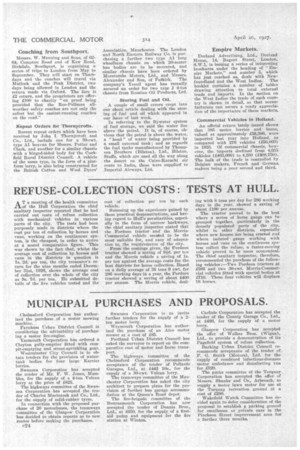REFUSE-COLLECTION COSTS: TESTS AT HULL.
Page 46

If you've noticed an error in this article please click here to report it so we can fix it.
AT a meeting of the health committee of the Hull Corporation the chief sanitary inspector reported that he had carried out tests of refuse collection with mechanical vehicles in various parts of the city. The tests had been purposely made in districts where the cost per ton of collection by horses and vans, working on the continuous system, is the cheapest, in order to arrive at a sound comparative figure. This was shown by the fact that, whilst the average cost of collection by,horses and vans in the districts in question is 7s. 2d. per ton, the city treasurer's return for the nine months ended December 31st, 1926, shows the average cost of collection over the whole of the city as 9s. '7d. per ton. He submitted details of the five vehicles tested and the
cost of collection per ton by each vehicle.
Summing up the experience gained by these practical demonstrations, and having regard to Hull's peculiarities, especially in the form of narrow backways, the chief sanitary inspector stated that the Fordson tractor and the MorrisCommercial vehicle seemed to be the most suitable for, and easy of adaptation to, the requirements of the city.
From the costings given, the Fordson tractor showed a saving of flid. per ten and the Morris vehicle a saving of is. per ton against the average costs for the best districts for horse collection. Based on a daily average of 36 tons 9 cwt. for 286 working days in a year, the Fordson tractor showed a saving of about £400 per annum. The Morris vehicle, deal
ing with S tons per day for 286 working days in the year, showed a saving of about £100 per annum.
The tractor proved to be the best where a series of horse gangs can be grouped together, particularly in the densely populated parts of the city, whilst in other districts, especially where new houses are being erected and where isolated gangs working with horses and vans on the continuous system collect the refuse, a faster-moving vehicle proved to be more economical. The chief sanitary inspector, therefore, recommended the purchase of the following vehicles :—Two Fordson tractors at £586 and two 30-cwt. Morris-Commercial vehicles fitted with special bodies at 1710. These four vehicles will displace 16 horses.












































































































